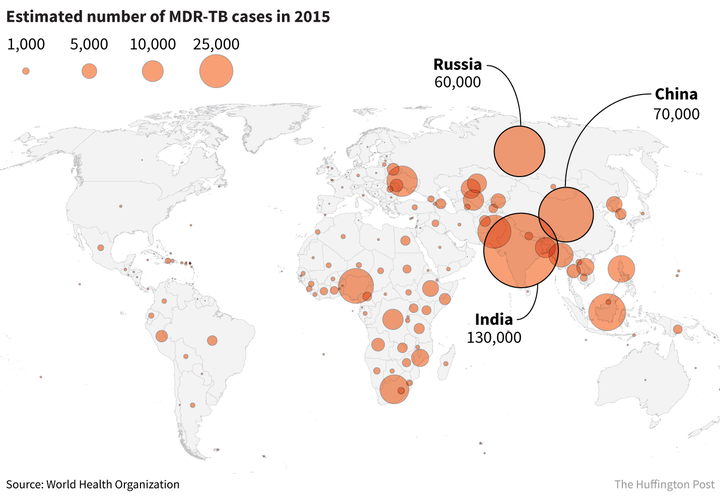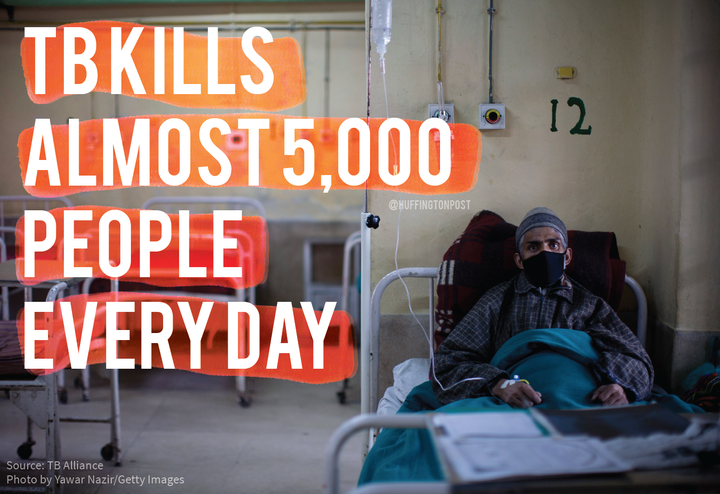The deadliest forms of tuberculosis are worsening in four of the countries with the largest number of TB cases, according to a new report in the Lancet Infectious Diseases journal.
While tuberculosis, when treated, has an over 83 percent cure rate on average globally, multidrug-resistant TB (MDR-TB), which is resistant to the standard TB antibiotic regimen, has about a 52 percent survival rate if treated. Extensively drug-resistant TB (XDR-TB) has a 28 percent survival rate when treated.
Currently, almost 40 percent of all multidrug-resistant tuberculosis cases ― about 230,000 ― occur in Russia, India, the Philippines and South Africa, according to Lancet.
And this study predicts that by 2040, a third of all tuberculosis cases in Russia, 1 in 10 in India and the Philippines, and 1 in 20 in South Africa are expected to be multidrug-resistant. In 2000, only 24.8 percent of cases in Russia, 7.9 percent in India, 6 percent in the Philippines and 2.5 percent in South Africa were multidrug-resistant.
Increasingly, the report argues, drug-resistant tuberculosis will be caused by person-to-person infection, rather than acquired resistance.
“Many people believe that if you do a good job finding or treating people with drug-susceptible TB, that is, if you don’t create it in the first place, then it’ll go away by itself,” said Dr. Peter Cegielski, team lead for prevention, care and treatment of the Centers for Disease Control and Prevention Global TB Branch. “But what this study shows is that it’s not going to happen.”
As Cegielski put it, there’s already too much drug-resistant TB out there, and it will continue to transmit from person to person without a marked increase in efforts to combat it.
For Lucica Ditiu, the executive director of the international Stop TB Partnership, the report emphasizes what the TB community knows.
“We’ll never see the end of the epidemic with continuous transmission happening,” she said.

“This is an airborne disease ― it doesn’t respect any kind of political boundaries,” Cegielski said. He added that the research and drugs we have for TB, which is the world’s top infectious disease killer, are behind the scale of the epidemic.
“The drugs we have now were created in the middle of the 20th century, but the problems we have now are 21st-century problems.”
For Eric Goosby, the United Nations special envoy on tuberculosis, the Lancet report underlines that TB is here to stay unless there is a marked uptick in the resources devoted to fighting it.
“Global response is the only way we will contain this,” he said.

Advocates point to a growing momentum and interest marked by the scheduling of a a ministerial conference in Russia in November and the first-ever U.N. high-level meeting focusing solely on TB in 2018.
But, at the last major ministerial meeting in 2009, the member states of the WHO vowed to “address the alarming threat of M/XDR-TB” that affected over 50 countries.
MDR-TB is now in over 153 countries.
“Multidrug-resistant tuberculosis is a crisis. We have declared it a public health crisis,” said Dr. Mario Raviglione, director of the World Health Organization’s Global TB Programme. “We keep repeating it is a crisis and we keep repeating that it requires investment.”
The WHO declared tuberculosis a global health emergency in 1993. Since then, drug-resistant cases have increased.
“This remains an orphan cause,” Raviglione said.
